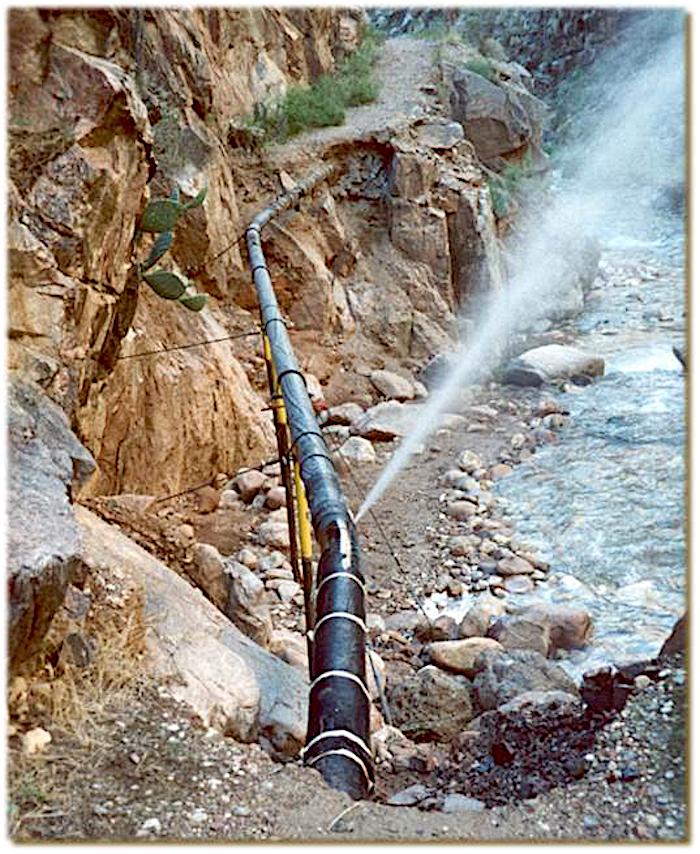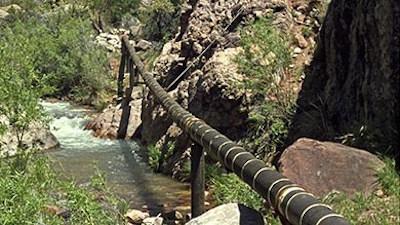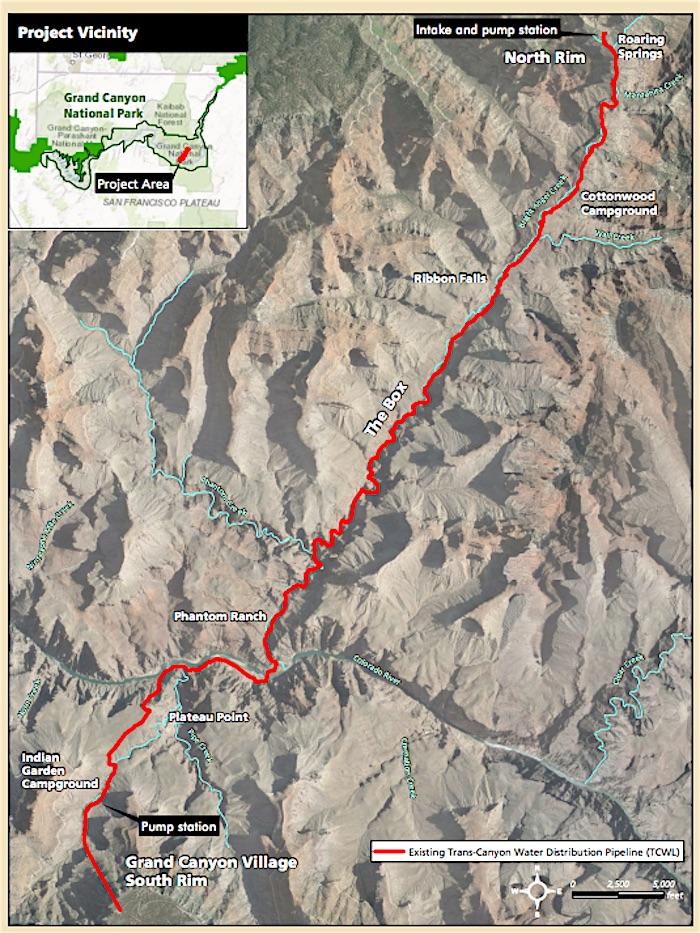
Frequent breaks in the Grand Canyon's Transcanyon Waterline have crews searching for a new water source/NPS file
Work over the next few days near Phantom Ranch in Grand Canyon National Park will help park staff determine whether a new water source for the antiquated and break-prone Transcanyon Waterline can be found and so greatly reduce the miles of pipeline needed to provide water to the South Rim where the bulk of the park's visitors gather.
Three wells will be drilled uphill of the ranch complex, with one to test the water supply there and two others to monitor for any impacts. On Thursday a helicopter was to haul in the drill rig and supplies for the project, which was expected to take three-four days, said Grand Canyon spokeswoman Kirby-Lynn Shedlowski.

A stretch of the Transcanyon Waterline along Bright Angel Creek in Grand Canyon/NPS
The project is needed, she said, to determine whether the pipeline can be shortened.
When it was designed and built back in the 1960s, the pipeline intake was at Roaring Springs, located about 3,500 feet below the North Rim. From there the pipeline follows the bends and twists of the North Kaibab Trail down to Phantom Ranch, where it crosses the Colorado River suspended beneath the "silver bridge."
Once across the river the pipeline goes uphill to Indian Gardens, where a pump station is used to push the water to the South Rim.
The decripit nature of the pipeline -- it breaks between five and 30 times a year, according to the Park Service, at a cost of roughly $25,000 per repair -- prompted the park to release a scoping document last August that touched on three alternatives: do nothing, replace the entire pipeline in its current location, or see if a new water intake well could be found near Phantom Ranch. Such an intake would remove the pipeline from a long downhill run through an area known as "The Box."
The park spokeswoman said the pipeline from Roaring Springs down to Phantom Ranch runs about seven or eight miles.

Map of existing Transcanyon Pipeline at Grand Canyon National Park/NPS
"This is a feasibility study for the future replacement of the Transcanyon pipeline," said Ms. Shedlowski. "We still have the current pipeline, which still has current issues of breaking, and so this feasibility study is not tied to any sort of repairs. It's just the feasibility of understanding what are our options so that they can complete the EA (environmental assessment) and complete the alternatives."
Since the stretch of pipeline "from Roaring Springs to Phantom Ranch is the part of the pipeline that has the most breaks" due to the bends it takes along the way, according to the spokeswoman, relocating the intake would save money in future repairs.
Under this alternative, if it proves possible, there would remain a short stretch of 2-inch pipeline from Roaring Springs to the Cottonwood Campground, but the bulk of the spring's output would "flow down out of Roaring Springs, down Bright Angel Creek naturally. Then we've reduced that (pipeline) vulnerability to future pipeline breaks," said Ms. Shedlowski.
In 2015, crews replaced 2,800 feet of pipeline near Phantom Ranch at a cost of $3.5 million. Earlier this month, breaks and pump failures at Indian Garden forced the park to order water conservation measures, including serving meals on disposable dishes in restaurants, turning off sinks in restrooms, and asking visitors and employees to shorten their showers.
On Wednesday, a week-and-a-half after the conservation measures were put in place, some were lifted as the South Rim's storage tanks had been filled to "sustainable levels." But with heavy visitation expected for Easter weekend, other restrictions remained in force.
"Visitors and residents are reminded that other Level 3 water restrictions remain in place, including the temporary closure of Camper Services (showers, laundry, and RV dump/fill station)," a park release said. "Sinks in public restrooms remain turned off and hand sanitizer is provided for use. Visitors and residents should continue to be mindful of their water use by turning off water when brushing teeth or shaving, collecting water in buckets while waiting for the shower to heat up, washing only full loads of dishes or laundry, selectively flushing toilets, and reporting wasteful water use and leaks."



Add comment